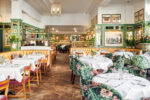From Billboards to Buses: Why Real-World Advertising Still Captivates Audiences

In a world where algorithms dictate what people see, skip, or scroll past, something remarkable is happening: real-world advertising is taking back the spotlight. Despite the dominance of digital channels, Out-of-Home (OOH) advertising – from billboards to buses, taxis, and train stations – continues to captivate audiences like no online banner ever could.
This isn’t a nostalgic return to the past; it’s a reinvention of visibility. Physical advertising is thriving in the digital era precisely because it does what digital can’t – it connects with people authentically, in shared spaces. Whether it’s a towering billboard above a busy junction, a branded taxi weaving through the city, or a glowing digital display in a crowded Underground station, one truth stands out: people may live online, but they look up in the real world.
The Enduring Power of Real-World Advertising
Why People Still Look Up
In 2025, the average person spends nearly eight hours a day on digital devices – phones, tablets, and screens that endlessly compete for attention. Yet, studies consistently show that people remember messages better when experienced in a physical environment.
A large billboard or a wrapped bus doesn’t blend into a feed or get lost in a scroll. It dominates the space it occupies. It’s part of the journey, the neighbourhood, the routine. That tangible presence transforms ads into experiences.
That’s why brands continue to invest heavily in real-world formats. A smartly placed billboard, designed by a specialist billboard advertising agency, can turn a simple slogan into a cultural moment. From Times Square to Piccadilly Circus, these large-scale visuals deliver impact, emotion, and visibility in ways no digital campaign ever can.
A Counterbalance to Digital Fatigue
Consumers are growing weary of pop-ups, pre-rolls, and ultra-targeted ads that follow them everywhere online. The constant noise has led to one of modern marketing’s biggest challenges – ad fatigue.
Physical advertising offers a refreshing escape. It’s public, visual, and unskippable, but not intrusive. It integrates naturally into daily life, sparking curiosity and emotion rather than interruption.
This subtle difference has driven many brands – even those born online – to rediscover the power of the physical world. Real-world campaigns feel honest. They don’t chase people; they meet them.
From Billboards to Buses – The Formats That Still Work
The Billboard Renaissance
Billboards have long been the champions of outdoor advertising, and their evolution continues. Today’s digital displays can change messages in real time – reflecting the weather, time of day, or even trending topics.
When managed by a skilled billboard advertising agency, modern billboard campaigns combine data, creativity, and strategy. They ensure each placement captures not just attention, but imagination. A single digital billboard can host multiple campaigns daily, allowing brands to maximise exposure and adaptability.
Billboards are no longer static – they’re living, responsive stories told on the skyline.
The Moving Impact of London Taxi Advertising
If billboards are the icons of permanence, London taxi advertising represents motion and reach. Each black cab is a moving message – a piece of design that travels through the city’s busiest districts every day, crossing paths with millions of potential viewers.
A well-executed taxi wrap transforms the city into a storytelling medium. Whether seen stuck in traffic or parked on a high street, it projects visibility, mobility, and charm.
For local businesses, taxi campaigns deliver an unbeatable mix of prestige and proximity. For global brands, they offer constant repetition across London’s commercial and cultural heart.
London Underground Advertising: Capturing the Captive Audience
The London Underground remains one of the most powerful environments for engagement. Millions of daily commuters pass through tunnels, platforms, and escalators, often with little to distract them – creating a rare moment of focus.
London Underground advertising thrives in these high-dwell spaces. Whether it’s dynamic digital screens or full-station branding, the impact is enormous. A well-crafted campaign doesn’t just fill the walls; it fills the imagination.
Few other advertising environments allow such immersive storytelling – especially at the scale and frequency the Underground provides.
Buses, Street Furniture, and Everyday Spaces
Beyond billboards, taxis, and trains, real-world campaigns extend to bus shelters, street furniture, and retail zones. These formats bring brands to where people move, wait, and interact – at eye level, in their communities.
Every format plays a role:
● Bus wraps build large-scale familiarity.
● Shelter posters deliver frequent, close-up exposure.
● Street furniture provides subtle, localised reinforcement.
Together, they form a network of touchpoints that drive awareness and recall organically, without intrusion.
The Rise of Data-Driven Creativity
The perception that outdoor advertising can’t be tracked or measured is now outdated. Technology has made it one of the most accountable marketing channels available.
Through mobile integration, geolocation, and even search monitoring, advertisers can measure exposure, engagement, and real-world impact. A local restaurant can run a campaign near a busy station with a QR code offering a discount – and then track how many people redeem it.
Real-world ads can now trigger digital actions, bridging the physical and online experience.
This is where agencies like Excite OOH are leading innovation – combining physical storytelling with real-time analytics. They create campaigns that live both on the street and in the cloud, connecting awareness to measurable behaviour.
Why the Streets Still Build Trust
In an era where misinformation and over-targeting have eroded consumer confidence, real-world ads carry something digital can’t replicate – credibility.
Seeing a brand in public space implies permanence. It signals investment, reliability, and authenticity. A billboard can’t be faked; it’s there for all to see.
This visibility also creates emotional connection. Outdoor campaigns interact with context – a cheerful ad on a grey morning, or a hopeful message during rush hour. They form emotional links between brand and audience through shared moments.
Real-world advertising succeeds because it’s not hidden behind algorithms – it exists in the open, where trust is built naturally.
The Future Is Hybrid – Physical Meets Digital
The most powerful campaigns of the future won’t choose between digital and real-world – they’ll blend both.
Imagine a billboard that connects to a phone through near-field technology or a taxi wrap that unlocks an augmented reality experience. The integration of digital tools with physical visibility is redefining what ‘engagement’ really means.
With creative strategy and data precision, agencies like Excite OOH are proving that outdoor campaigns can drive online conversions, social sharing, and brand loyalty all at once.
In a digital-heavy world, the smartest brands are looking outward – to the streets, the stations, and the spaces where people truly live their lives.
Final Thoughts
From billboards to buses, taxis to train stations, the real world remains one of the most powerful canvases for storytelling. Physical advertising stands out not because it resists technology, but because it humanises it.
When people step away from their screens, they reconnect with their surroundings – and with the brands that meet them there. That’s the enduring magic of real-world advertising: it doesn’t chase attention, it earns it.
Even in a hyper-digital age, the campaigns that resonate most aren’t confined to screens – they’re the ones people can’t scroll past, the ones that make them look up and remember.








![Merlin [Northern Ballet] – Review – Sheffield Lyceum (3)](https://www.on-magazine.co.uk/wp-content/uploads/Merlin-Northern-Ballet-–-Review-–-Sheffield-Lyceum-3-150x100.jpg)

